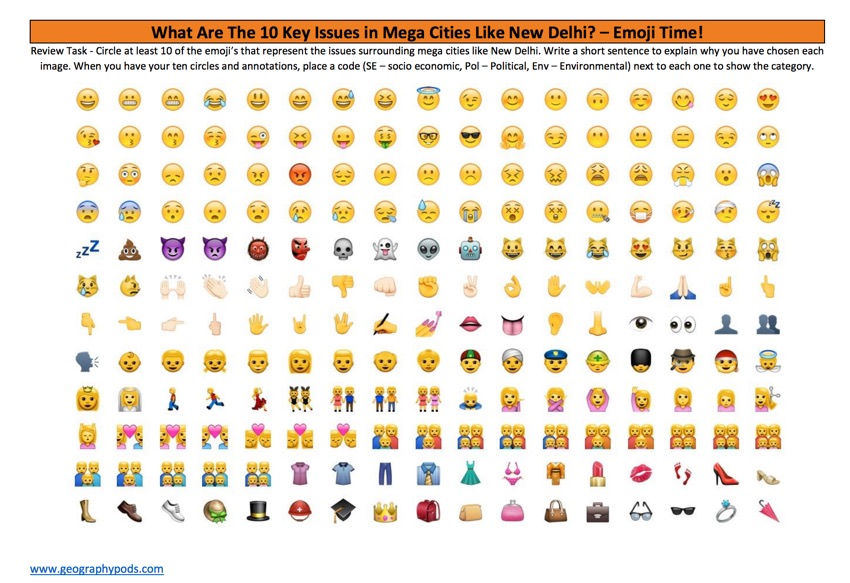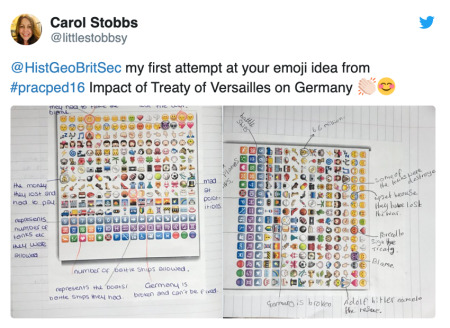Emojis. Cause they’re good for kids and fun to use. What’s not to like?
One of my fave conversations centered on the idea of using emojis as a way to help kids make sense of social studies and incorporating them as part of a quality lesson that can help improve student thinking and literacy skills.

I always walk away smarter after spending time with classroom teachers. Wednesday was no exception. I got the chance to work with about 35 K-5 teachers and spent the day focused on the Inquiry Design Model – tweaking previous IDMs and developing new ones for next semester. And in addition to finding out about some new ways to integrate primary sources, a teacher shared this little gem:
“Never wear white when teaching Kindergarten.”
If you teach K-3, you already knew this. But for secondary folks like me? Good tip.
I’m not sure that there is any sort of measurement tool able to document the level of respect I have for elementary teachers. But that’s it, right there in a nutshell. Teaching five year olds is hard enough, what with all the reading, writing, arithmetic, social emotional, classroom management stuff. But now I find out that my wardrobe choices are also impacted. (And you really don’t want to hear the reasons why white is a bad choice. Trust me. Seriously . . . just walk away.)
Once we got past the never wear white idea, we had the chance to jump into our work on their IDMs. Including some conversation about effective teaching strategies and activities. One of my fave conversations centered on the idea of using emojis as a way to help kids make sense of social studies and incorporating them as part of a quality lesson that can help improve student thinking and literacy skills.

And yes, I can hear you. You’re saying that integrating little graphic images used by millions of Instagram tweeners instead of more traditional tools is no way to teach historical thinking and literacy. But I’m convinced that these little graphic images have tremendous potential to help kids makes sense of evidence, increase literacy skills, and demonstrate learning.
We started our day on Wednesday introducing the idea by using a fun web tool called Emoji Scavenger Hunt. We got into groups and raced around the building, collecting actual objects that matched emojis provided by the game. It was a great way to kickstart the conversation.
Tools and ideas to transform education. Sign up below.
You can get an idea of the emoji potential by taking a look at how Omaha middle school teacher Lance Mosier uses emojis to help kids summarize and demonstrate an understanding of what life was like for soldiers fighting in the Civil War.

Start wrapping your brain around some of the other possibilities:
- Direct adaptations of what Lance is doing could include asking kids to think about World War II soldiers or people living through the Great Depression.
- Ask students to analyze political cartoons using emojis to describe the emotions created by viewing the cartoon. What was the intent of the cartoonist? Make lists of emojis for different groups of people viewing the cartoon. What would be the reaction of Republicans to the cartoon? Democrats? Independents? Rural or urban? Young or old? Readers in other countries? (Scroll down a bit through this short article by Control Alt Achieve to get a Google Doc template that would help with this.)
- I love the idea of asking kids to code text while reading primary and secondary sources. Encourage students to use a closed set of emojis you create or even better . . . allow them to develop their own set that helps them make sense of the text.
- What might it look like if you were to combine emojis with the SHEG Historical Thinking Chart? The thinking and writing prompts in the far right column seem like perfect places for students to start using emojis.
- Disney has created a YouTube playlist that recreates some of their movies using emojis. (Yes. I watched a few of them. Gotta go with Tangled.) But instead of Tangled, why not ask kids to create a video story of the modern Civil Rights movement using emojis? Or the writing of the Declaration of Independence? Or the spread of different religions? The Gold Rush?
- Maybe not an actual movie. Maybe just use the Google Docs > Insert > Special Characters > Emoji option or a Chrome browser extension to have kids create the storyboard or script for the movie.
The key to all of these is to not just ask kids to select emojis but to explain their thinking. Why did they select those emojis?
Lance also shared a few other online resources that helped him develop his Civil War emoji idea:
- Russel Tarr is a social studies superstar with amazing ideas and resources. This post highlights how he uses emjois to develop vocabulary and source analysis skills.
- Erin Flannagan has some great elementary emoji ideas.
- Matt Podbury, Russel’s geography colleague, uses emjois to help students identify and summarize issues affecting major urban centers.

And Carol Stobbs uses emjois to support student research on the Treaty of Versailles.

So . . . if you’re keeping score so far, we’re now using emjois for:
- sourcing and contextualizing of primary sources
- analyzing political cartoons
- measuring and highlighting author voice and tone
- summarizing
- exit cards
- writing a rebus story
- formative assessment of knowledge
- close reading and character analysis
- summative assessment writing prompts
- surveys
- made movies and wrote scripts
And all of these ideas fit across all of the social studies disciplines. I especially love the combination of analog and digital options for using emjois as well of how both visuals and text are part of these activities.
Much like memes, Frayer Model graphic organizers, and other visually based activities, integrating emojis is a powerful method for helping students create their own schemas and frameworks for learning. Made to Stick by Chip Heath and John Medina’s Brain Rules are just two of the many resources that document the power of combining visuals with text to improve learning.
Strategies that incorporate emojis can motivate learners, trigger emotional connections, improve comprehension, transmit content faster, and aid in retention. Emoji-based activities also support the teaching, learning, and doing of a wide variety of literacy skills.
And who doesn’t like that?
cross posted at glennwiebe.org
Glenn Wiebe is an education and technology consultant with 15 years' experience teaching history and social studies. He is a curriculum consultant for ESSDACK, an educational service center in Hutchinson, Kansas, blogs frequently at History Tech and maintains Social Studies Central, a repository of resources targeted at K-12 educators. Visit glennwiebe.org to learn more about his speaking and presentation on education technology, innovative instruction and social studies.
